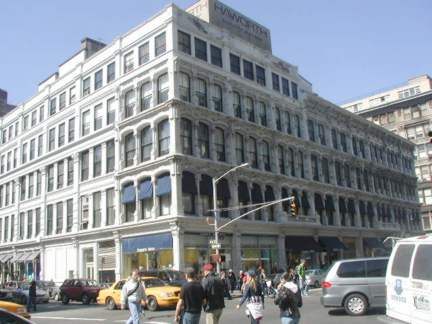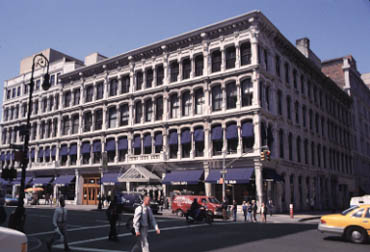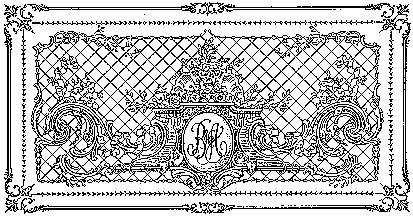 |
New York
Architecture Images-Soho B. Altman Dry Goods Store |
|
architect |
D. and J. Jardine [c.1877] William H. Hume [1887]; Buchman & Fox [1909] |
|
location |
621 6th Avenue |
|
date |
1877 |
|
style |
Neo-Grec Renaissance Revival |
|
construction |
Cast Iron Facade |
|
type |
Shop |
|
|
|
|
images |
 |
|
|
 |
|
Ladies' Mile: With R. H. Macy leading the way in the mid-1850s with a flagship store at Sixth and 14th, and A.T. Stewart's Cast Iron Palace at 9th Street, Sixth Avenue from 9th north to 23rd is lined with big, buxom Beaux-Arts buildings that catered to ladies who lunched and then shopped. In Ladies' Mile heyday, over a dozen huge emporia lined the avenue...but were thrown into shadow until 1939, when the el was razed. After that, the stores could be seen in all their glory...which faded rapidly as the years went by as the buildings slowly decayed. They were in sad shape indeed until, gradually and slowly at first, they began to be restored in the late 1980s until today, Sixth Avenue is as busy and bustling a shopping street as it ever was. The old B. Altman's building was used by the firm between 1877 and 1906 when it moved to a new store encompassing an entire city block, 5th to Madison and 34th to 35th, until the store closed its doors forever in 1989. That means B. Altmans' has left behind not one but two of NYC's most beautiful buildings. See also the midtown B. Altman Department Store
Built by the Altman family, the presence of this popular "palace of trade" on 18th Street signalled the decline of Soho as the city's main retail district. In 1906, B. Altman's followed the northward expansion of New York's residential area to Fifth Avenue and 34th Street. An important American entrepreneur, Benjamin Altman was also a trendsetter in women's fashion. He sold fine fabrics for custom-made dresses while at the same time he showed off the new possibilities of the sewing machine with ready-to-wear goods. An innovative employer and salesman, he provided a number of amenities for his employees and introduced home delivery to a receptive, more affluent consumer base. Expanded from a small building adjacent to 19th Street, the block-long store was clad in cast iron along its Sixth Avenue side with exposed brick along its three secondary facades. With its thin pilasters and colonnettes and its intricate cornices, this cast-iron facade is articulated in the light and delicate Neo-Grec style. Wide ground floor storefront windows were decorated with sculptures and clothing displays in order to attract customers. Riding by the store on the Sixth Avenue Elevated Subway (the 'El' for short), consumers' attention would have been drawn to the ornate second story-view.  The greatness of a city is measured always, in the minds of men, by its commercial importance. Where the central marts of business are, there are also to be found all that is most admirable, because most progressive, in human experience. The world we live in is essentially a vital world, pulsating with vigorous life. It is a world of workers; of men who dream great deeds, and do them before the dream is finished. It is a world in which nothing is too insignificant to merit man's consideration; no goal too exalted to be beyond his attainment. And it is the men who have possessed the intuition to recognize these sublime truths, and the courage to pattern their lives thereby, who have achieved success. Such a man was Benjamin Altman, who, in the days when the city of York was scarcely out of its infancy, gave to the dry goods house which proudly bears his name -- and as proudly the impress of his dominating personality -- the impetus which forced it onward and upward, through years of patient, unremitting labor, to its present prosperity. Mr. Altman, even in those early days, fully grasped the potentialities of the upright, honest merchant who could make fair dealing and impeccable reliability the watchwords of his life in and out of business; and, throughout his long and eventful career, never did he deviate from the path of integrity that he had mapped out for himself in the beginning. The foundations of the Altman business were laid in a small store on Third Avenue, near Tenth Street. Here Benjamin Altman, then little more than a youth, but already equipped with the keen discernment and balanced judgment of maturity, began to carve out his great future. Selecting his merchandise with the fine artistic taste and the infallible sense of values which were among his most salient characteristics, and paying cash for every bill of goods he purchased, he early established, both for himself and his store, a reputation for reliability which has never been assailed because it is unassailable. Toiling early and late, dedicating all that he had and was to his work, he was rewarded by the steady growth of his business. In the early seventies he removed it from Third Avenue to Sixth Avenue -- then important shopping center -- where he occupied an unpretentious store between Twenty-first and Twenty-second Streets. In 1876 he took possession of more spacious quarters on Sixth Avenue at Nineteenth Street, where the Altman store made history for itself for thirty years. It was during these eventful years that the store came to be recognized as the leading dry goods house of the city of New York. Its elegant appointments, its atmosphere of refinement, appealed to the most "elusive members of society, not only of its own city, but far afield; while the superiority of its varied merchandise became a household word in the world of fashion. Meanwhile Mr. Altman, with unerring prescience of the inevitable northward trend of mercantile New York, and urged by the rapid and persistent increase of his business, began to plan for an uptown store whose commodiousness should be commensurate with the constantly growing demand. In 1905-6 the firm of B. Altman & Co. erected their new store on the east side of Fifth Avenue, between Thirty-fourth and Thirty-fifth Streets. The first parcel of land for its site had been acquired by Mr. Altman some ten years earlier; and from time to time thereafter other lots had been purchased or leased from their various owners until Mr. Altman possess what he believed to be an ideal site for the imposing store he purposed to erect in the heart of New York's most exclusive shopping district. The opening of the Fifth Avenue store of B. Altman & Co. marked an important epoch in the mercantile history of New York. The aristocratic avenue, so long sacred to the resident wealth and fashion of America's metropolis, had for some time been gradually yielding -- with more or less gentle protest -- to the encroachments of business; now it gracefully capitulated. The high-class dry goods store, with its beautiful architecture, its allure of attractive merchandise, its fashionable clientele, brought about a transformation that was at once decisive, brilliant and complete.
But Mr. Altman's ideal had not yet been attained. The store he planned was still larger, still more commodious; a store in which shopping in which shopping was to become a pleasure instead of a task; a store in which the patron's need were not merely to be supplied, but anticipated; a store in which the personal comfort, not of patrons only, but of employees also, was to receive the most thoughtful consideration. It was to be a store of infinite resources; equipped with every device calculated to contribute to the greatest efficiency of service; in brief, a store of the highest modern order. With these aims in view, the twelve-story addition on Madison Avenue has been erected. With its completion, the store of B. Altman & Co. becomes not only one of the largest dry goods establishments in the world, but also one of the most completely equipped. It now occupies an entire city block, extending east from Fifth Avenue to Madison Avenue, and north from Thirty-fourth Street to Thirty-fifth Street. Within this immense building every modern improvement known to architectural and engineering science is in active operation, rendering it technically perfect as to light, heat, ventilation and distribution of floor space. The new addition, like the original building, follows in detail the dignified style of the Italian Renaissance, complete harmony of design and character being preserved throughout. French limestone, quarried and imported especially for the purpose, has been used in constructing the entire building (the Madison Avenue front alone excepted) up to and including the eighth floor, the remaining four floors (of the superstructure) being of white glazed brick. On the side fronting Madison Avenue the central elevation is of white brick above the second floor, the corner pavilions at each side being of French limestone to the eighth floor. Large display windows lend distinction to the Madison Avenue corners at Thirty-fourth and Thirty-fifth Streets; and a spacious vestibule, with marquise extending over the sidewalk to the curb, forms a stately and impressive entrance, especially convenient for patrons arriving in carriages and private motors. A very commodious carriage entrance, with enclosed portico for the shelter of patrons awaiting their vehicles, is located on Thirty-fifth Street. |
|
|
links |
|